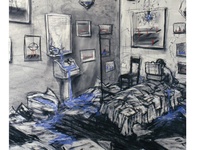LASTING TRACES
The uncertainty and indecision Kentridge describes may reflect the difficulty of representing his films’ grim subject-matter: the aftermath of apartheid, which he likens to an “immovable rock.” “The scale and weight with which this rock presents itself is inimical to that task [of representation,]” Kentridge wrote in 1990 of the apartheid. Despite the formidable task of depicting these atrocities, he maintains that the artist’s studio can serve as a retreat in which to represent and work through the memory of the past.
In his second lecture, Kentridge suggested a link between the challenge of representing tragedy and his concept of the universal archive. He proposed that the lingering images of every event to have occurred on earth are preserved and projected into space in the form of photons moving at the speed of light. Though the photons travel further away from earth, these images of human history may still be visible to a well-positioned observer. “The universe is a collection of images.... We are transmitting stations broadcasting ourselves the whole time,” Kentridge said. “Once launched, the image cannot be called back.”
The concept of projected images that are not fleeting but lingering in three-dimensional space relates to the technique behind Kentridge’s drawings for projection. The material build-up resulting from the artist’s repeated alteration and erasure of charcoal marks parallels the accumulation of events in the universal archive. Without explicitly engaging the specific political figures and events of post-apartheid South Africa, Kentridge’s suggestive layering of marks reflects the ever-present memory of “the rock,” even as it resists direct representation.
“NECESSARY STUPIDITY”
Kentridge has several times punctuated his lectures with variations on the phrase, “And now, we must return to the studio.” For Kentridge, the studio is the site of what he describes as a “full frontal assault” of multiple processes and ideas in which an artist may be engaged simultaneously. The non-verbal discoveries resulting from this multiform engagement can be difficult to translate from the workspace to the lecture hall. To illustrate this conflict, Kentridge projected four identically dressed images of himself which—as the real Kentridge paused in his delivery—continued to pace forward and backward on the screen overhead, reciting various thoughts and phrases from lecture notes to create an unintelligible, overlapping chorus.
According to Kentridge, an artist’s ability to operate on multiple fronts at once depends on his or her cultivation of ”necessary stupidity.” “The necessary stupidity refers to the activities which you can’t really explain in a rational way,” Kentridge said in an interview. “As soon as you start to explain them rationally, they are extremely foolish and don’t have a logical sense, but nonetheless are extremely important.” Though Kentridge does not elaborate on the exact nature of these activities, he associates them with an abandonment of linear thinking for an emphasis on observation and material exploration.
Kentridge’s commitment to asserting the primacy of this concept in the Norton lectures to an audience awaiting the display of brilliance is one of the drawing lessons’ greatest points of tension and interest. His promotion of this concept subtly critiques the privileged status of the more traditional, scholarly forms of knowledge in which much of Harvard’s community is engaged.
“His argument is that artistic practice is a form of knowledge production...and shouldn’t be viewed simply as a form of supplement or afterthought that takes place once the important work of, say, philosophy, or some other discipline has been done,” Gough says. “This was not a lecture solely for the art world or the art-history crowd....This was a lecture for a university with a complicated but potentially dynamic relationship to the advanced forms of experimental aesthetic practice.”
Bhabha suggests that though Kentridge may be critiquing the limitations of the lecture format, he works within it to present images on their own terms. “I would argue it was not only about art as knowledge production, but knowledge as art production at the same time,” Bhabha says of Kentridge’s first lecture. “He changed the lecture format because the visual materials he showed were not simply illustrations of something he had said. They had their own narrative which converged with the lecture.”
Kentridge suggests that privileging images over text naturally occurs in the delivery of an artist talk, but that it also reflects his conviction in the primacy of visual knowledge. “Argument and logic [are] something on top of the world, hovering over it, but not a part of it,” said Kentridge in his first lecture, describing his disillusionment early in life and the reason for turning to the “limitations and leanness of shadows” as legitimate sources of knowledge.
“If you’re artist and not a scholar then obviously your life has been not about words, but about images,” Kentridge said in an interview. “So to defend that activity of making meaning through practical activity, which is what artists do, is to show that there can’t always be a privilege of rational, word based thinking.”
—Staff Writer Sally K. Scopa can be reached at sscopa@college.harvard.edu.









